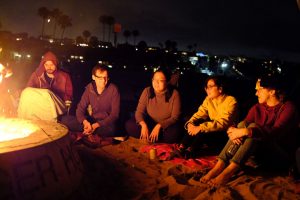It’s been quite a while since I the UA Group blog has been updated and quite a few things have happened recently, so here’s a quick update on events of the past year.
Graduates!
The UA Group now has minted 2 PhDs! In January 2021, Danielle Draper successfully defended her thesis entitled Understanding NO3 oxidation of monoterpenes at different scales: Insights from molecular modeling, chamber experiments, and field observations. She was soon followed by Sabrina Chee, who defended in May 2021 with a thesis entitled Understanding the Mechanisms of Salt Formation in New Particle Formation and Growth. Dr. Draper is now a postdoc in the Wennberg Lab at Caltech. Dr. Chee is at Lam Research, where she has entered the New College Graduate Rotation Program. Since the official UCI graduation ceremony was virtual this year, we decided to have a private hooding ceremony in Aldrich Park. Here’s a group picture from that day! We are so proud of you both, Sabrina and Danielle!
Research!
Even though much of the past year was spent sheltering at home, it was still a busy and productive year. Here are just a few highlights:
The entire research group contributed to the drafting of a review paper, Atmospheric clusters to nanoparticles: Recent progress and challenges in closing the gap in chemical composition, which was an invited review in the Journal of Aerosol Research. In this paper we review of the current state of measurements and modeling of 2-10 nm diameter atmospheric nanoparticle composition.
Continuing our fruitful collaboration with the Jiang Group at Tsinghua University, we published Composition of Ultrafine Particles in Urban Beijing: Measurement Using a Thermal Desorption Chemical Ionization Mass Spectrometer . By measuring the composition of the smallest particles in Beijing, we can understand the sources of this important component of air pollution. Cooking oil plays a large role!
This paper was the capstone of Sabrina’s thesis: A predictive model for salt nanoparticle formation using heterodimer stability calculations. In this purely theoretical study, we propose a shortcut for calculating new particle formation rates that involves only one calculation: the stability of the first acid-base pair (called heterodimer). Using this, we built a model that predicts particle formation rates at any temperature, pressure, and acid/base concentration.
Fun!
As the group became fully vaccinated and restrictions were lifted, we enjoyed hanging out and having fun together. Here are some pics from Sabrina’s defense party and Sabrina and Danielle’s beach bonfire.


